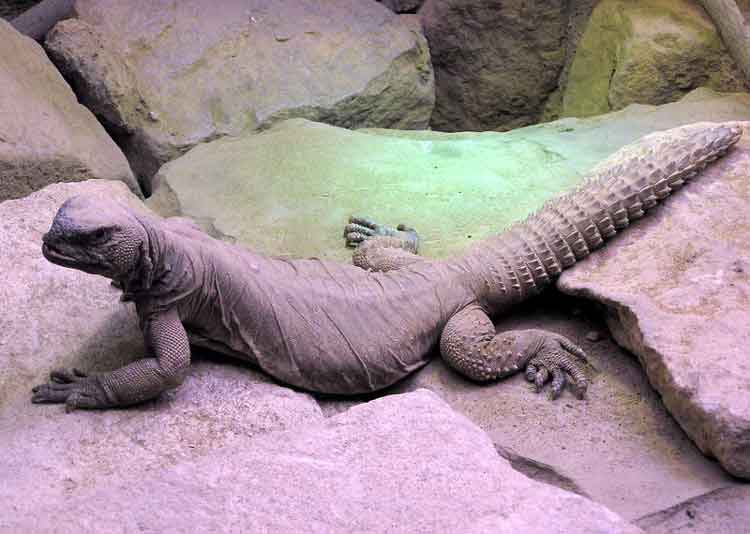
Uromastyx aegyptia (*)
Superregnum: Eukaryota
Regnum: Animalia
Subregnum: Eumetazoa
Cladus: Bilateria
Cladus: Nephrozoa
Superphylum: Deuterostomia
Phylum: Chordata
Cladus: Craniata
Subphylum: Vertebrata
Infraphylum: Gnathostomata
Superclassis: Tetrapoda
Cladus: Reptiliomorpha
Cladus: Amniota
Classis: Reptilia
Cladus: Eureptilia
Cladus: Romeriida
Subclassis: Diapsida
Cladus: Sauria
Infraclassis: Lepidosauromorpha
Superordo: Lepidosauria
Ordo: Squamata
Cladus: Unidentata Episquamata Toxicofera
Subordo: Iguania
Infraordo: Acrodonta
Familia: Agamidae
Subfamilia: Uromastycinae
Genus: Uromastyx
Species: Uromastyx aegyptia
Subspecies (3): U. a. aegyptia – U. a. leptieni – U. a. microlepis
Name
Uromastyx aegyptia (Forsskål, 1775)
Neotype: ZFMK 44216, adult ♂, collected by I. Rehak in August 1982. [designated by Wilms & Böhme (2000: 136)]
Type locality: “Aegypto [=Egypt]”, redesigned by neotype designation to “Egypt, Suez at the road to Cairo” by Wilms & Böhme (2000: 136).
Combinations
Lacerta aegyptia Forsskål, 1775: 13 [original combination]
Uromastix aegyptius — Anderson, 1898: 129 [subsequent combination]
Uromastyx aegyptia — Flower, 1933: 779 [subsequent combination]
References
Primary references
Forsskål, P.S. 1775. Descriptiones animalium avium, amphibiorum, piscium, insectorum, vermium; quae in itinere orientali observavit. Post mortem auctoris edidit Carsten Niebuhr. Ex Officina Mölleri: Hauniae [=Copenhagen]. 1–20 + i–xxxiv + 1–164 + 1 map. BHL Reference page.
Additional references
Wilms, T.M., Böhme, W., Wagner, P., Lutzmann, N. & Schmitz, A. 2009. On the Phylogeny and Taxonomy of the Genus Uromastyx Merrem, 1820 (Reptilia: Squamata: Agamidae: Uromastycinae) – Resurrection of the Genus Saara Gray, 1845. Bonner Zoologische Beiträge 56(1/2): 55–99. BHL Reference page.
Links
Uetz, P. & Hallermann, J. 2022. Uromastyx aegyptia. The Reptile Database. Accessed on 10 May 2019.
Wilms, T., Eid, E.K.A., Al Johany, A.M.H., Amr, Z.S.S., Els, J., Baha El Din, S., Disi, A.M., Sharifi, M., Papenfuss, T., Shafiei Bafti, S. & Werner, Y.L. 2012. IUCN: Uromastyx aegyptia (Least Concern) (errata version published in 2017). The IUCN Red List of Threatened Species 2012: e.T164729A115304711. DOI: 10.2305/IUCN.UK.2012.RLTS.T164729A1071308.en
Uromastyx aegyptia – Taxon details on Integrated Taxonomic Information System (ITIS).
Vernacular names
English: Egyptian Spiny–tailed Lizard
Uromastyx aegyptia is a species of lizard in the family Agamidae. The species is endemic to North Africa and the Middle East.[1]
Common names
Common names for U. aegyptia include Egyptian mastigure,[4] Egyptian spiny-tailed lizard, Leptien's mastigure,[5] Egyptian uromastyx and Egyptian dabb lizard.
Description
U. aegyptia is one of the largest members of the genus, with average lengths of 76 cm (30 in) for males.
Geographic range and conservation status
U. aegyptia can be found in Egypt,[6] Libya, Palestine, Israel and throughout the Middle East but is rarely found today due to reduction of habitat. The remainder of the population mostly inhabits the gravel plains of northern Oman and some parts of the eastern UAE and Saudi Arabia where it is listed as endangered and slowly vanishing due to the impact brought on by development. This species can also be found in barren regions within Qatar, though it is only rarely encountered.
Subspecies
Three subspecies are recognized as being valid, including the nominotypical subspecies.[3]
Uromastyx aegyptia aegyptia (Forskål, 1775)
Uromastyx aegyptia leptieni Wilms & Böhme, 2000
Uromastyx microlepis Blanford, 1874
Uromastyx aegyptia leptieni
Etymology
The subspecific name, leptieni, is in honor of German herpetologist Rolf Leptien.[7]
Economic use
U. aegyptia is locally known as dhab or ḍabb (Arabic: ضب). Its strong skin made good leather for the bedouins, while its meat was often considered as an alternative source of protein.[8]
Habitat
U. aegyptia lives in dry, rocky areas.[3]
References
Wilms T, Eid EKA, Al Johany AMH, Amr ZSS, Els J, Baha El Din S, Disi AM, Sharifi M, Papenfuss T, Shafiei Bafti S, Werner YL (2012). "Uromastyx aegyptia ". IUCN Red List of Threatened Species. 2012. Retrieved 4 September 2014.
"Appendices | CITES". cites.org. Retrieved 2022-01-14.
"Uromastyx aegyptia (FORSKAL, 1775)". The Reptile Database. Retrieved 2009-01-25.
http://jcvi.org/reptiles/species.php?genus=Uromastyx&species=aegyptia
http://animaldiversity.ummz.umich.edu/site/accounts/classification/Uromastyx_leptieni.html
Baha el Din, Sherif (2006). A Guide to Reptiles & Amphibians of Egypt. Cairo: The American University in Cairo Press. ISBN 978-9774249792.
Beolens, Bo; Watkins, Michael; Grayson, Michael (2011). The Eponym Dictionary of Reptiles. Baltimore: Johns Hopkins University Press. xiii + 296 pp. ISBN 978-1-4214-0135-5. (Uromastyx leptieni, p. 155).
Ghose, Tia (2014-03-05). "Leapin' Lizards! Medieval Arabs Ate the Scaly Creatures". LiveScience.com. Retrieved 2015-04-20.
Further reading
Forskål P (1775). Descriptiones Animalium, Avium, Amphibiorum, Piscium, Insectorum, Vermium; quæ in Itinere Orientali Observit. Copenhagen: Möller. 164 pp. (Lacerta ægyptia, new species, p. 13). (in Latin).
Retrieved from "http://en.wikipedia.org/"
All text is available under the terms of the GNU Free Documentation License

